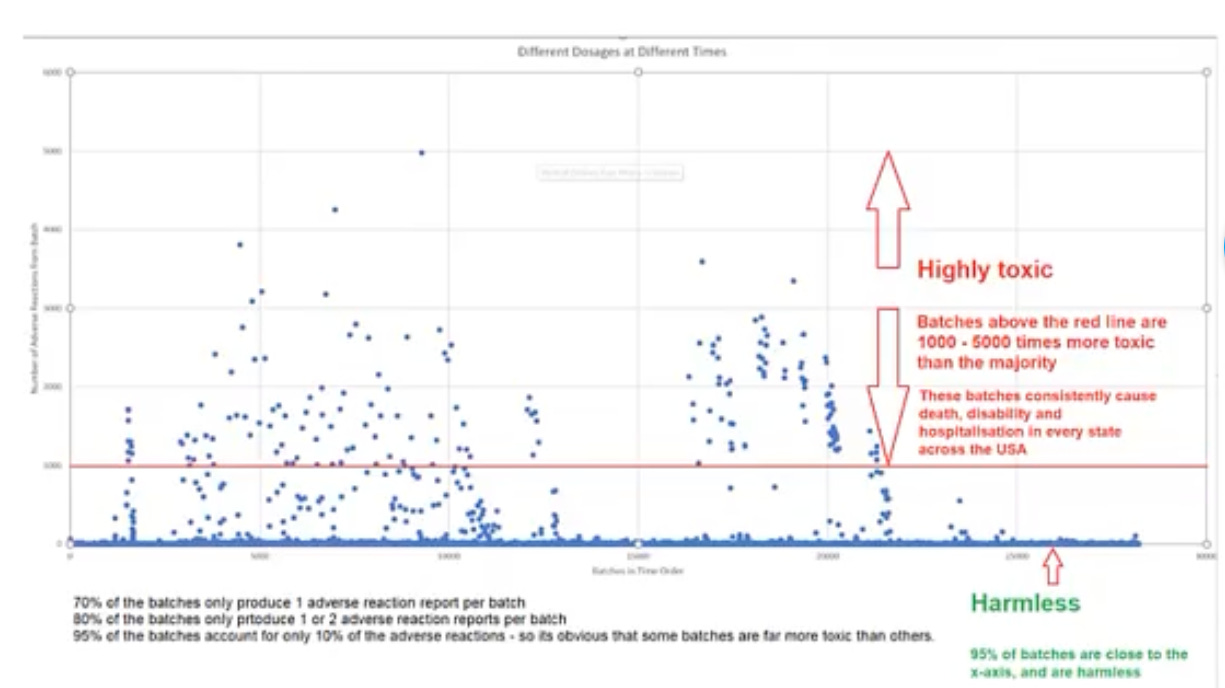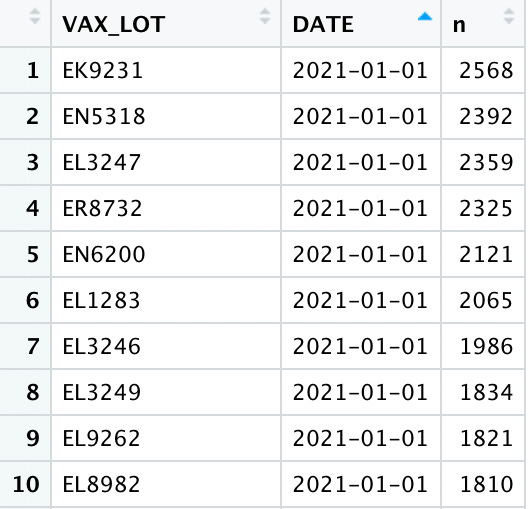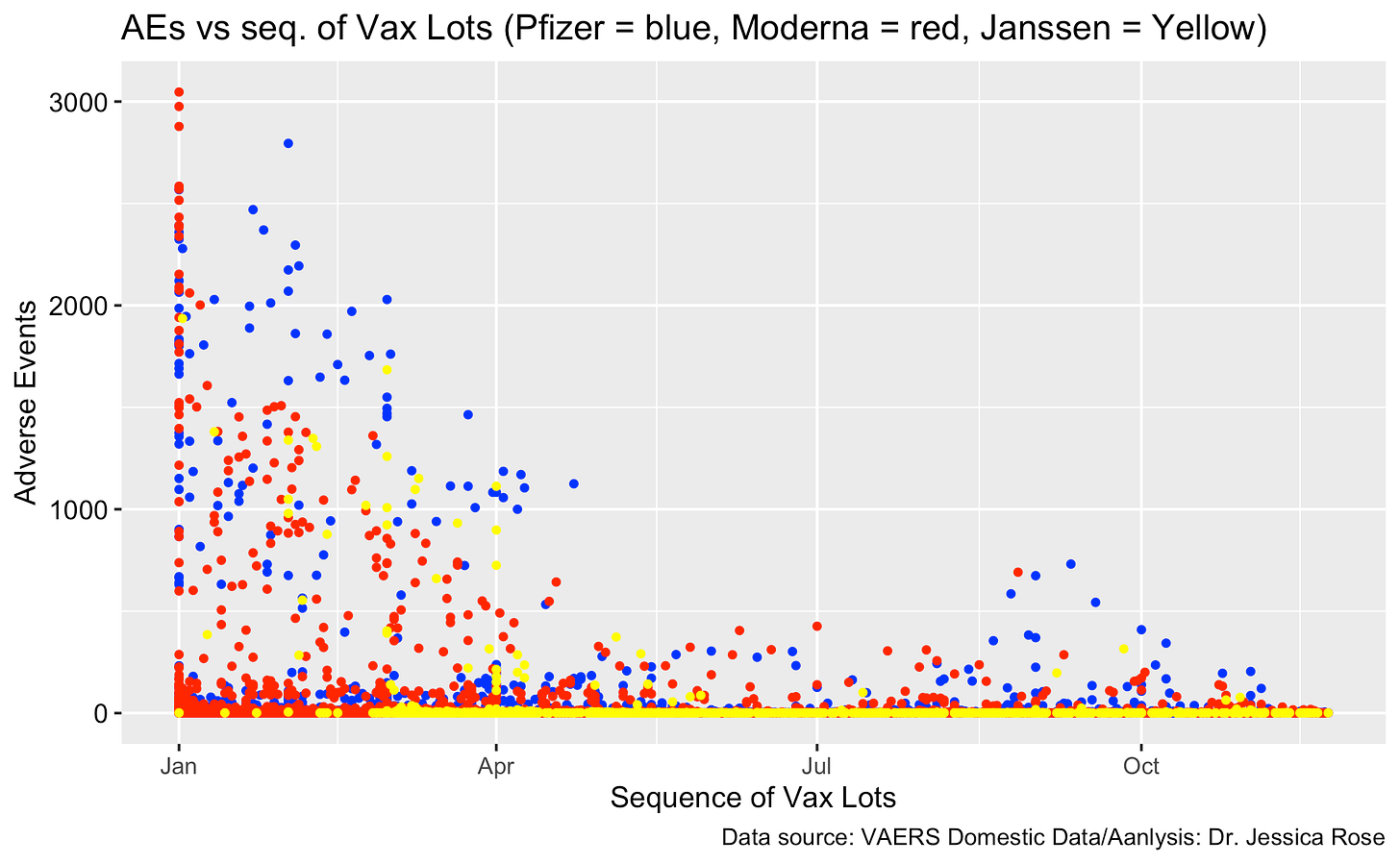There’s a new fascinating video out there in the inteur-web that is claiming that dangerous Vax Lots (VLs) (VLs more frequently associated with a higher number of Adverse Events (AEs)) are being deployed to the U.S. population, strategically, by staggering them, to ensure that these dangerous lots are always in the ‘system’ in an attempt to carry out ‘discrete dosage testing’. These VLs come from one of three COVID-19 injectable product manufacturers: Pfizer/BioNTech, Moderna or Janssen.
Let’s walk and talk through my thinking on this. In this substack post, I will talk around 2 graphs that were generated for the video (Figures 1 and 2) and the meanings of both. Figure 1 below is the first graph presented in the video.

This Figure shows all of the AEs reported to VAERS on the y-axis and the VLs administered in the U.S. on the x-axis. The hypothesis rests on the claim that the x-axis has a ‘time order’.
It is important to define what toxic means in this context. In this context, a ‘toxic’ VL is defined by its association with a higher number of AEs, as opposed to a VL that is more frequently associated with Severe AEs (SAEs). Now, since an increased number of total AEs probably does imply an increased number of SAEs, this is most likely not a wrong way to define ‘toxic’, but perhaps not the right way either. Toxic VLs could also be defined as an increase in association with SAEs which include death, life-threatening AEs, hospitalizations, ER visits, birth defects and AEs related to deformities or disabilities. But let’s leave that for now.
Certainly, and without a doubt, certain VLs - as per manufacturer - are more highly-associated with either more AE reports and/or more Severe AE reports. He states in the video that 95% of VLs are indeed associated with lower numbers of AE reports and, in fact, that 80% of the VLs generate only 1 or 2 AEs and thus are ‘harmless’ or not toxic. What if 1 of those 2 AEs was death? Now granted, most of these 1s are actually bogus VL entries. This is another point I need to make about VL data in VAERS. The VL are notoriously mis-labeled. Here is an example of what many singular VL entries look like:
Anyway, let’s accept this definition of toxic. The non-toxic or harmless VLs cluster around 0 on the y-axis. So there are particular VLs more highly-associated with large numbers of AEs. In other words, the claim is that any and every VL above the red line (Figure 1) is more toxic (according to his definition of toxic).
In the second part of the video presentation, the focus is on the distribution of the VLs by ‘deployment’ according to manufacturer. Figure 2 below is the second graph presented in the video.
According to Figure 2, there were very few Pfizer/BioNTech shots administered in the first part of the roll-out into the U.S. population that were associated with many AEs. This contradicts the fact that thousands of SAE reports were filed to VAERS in the first months of the U.S roll outs. And in alignment with our accepted definition of a toxic VL, there were toxic Pfizer/BioNTech VLs reported at the beginning of the roll out. By February 13th, there were already 3221 SAE reports in VAERS which, by the way, was above what the VAERS handbook defines as typical (it was actually 60% of the total. Eek). And to be more specific, Pfizer/BioNTech VL EK9231 (associated with 2568 AEs) was injected into arms on January 1, 2021 (Table 2). So, if we consider what the distribution would look like in a temporal setting of toxic VLs, we would see a more even distribution of the data, I believe. Table 2 shows Pfizer/BioNTech VLs associated with thousands of AEs in January just to provide the reader with an idea of just how many AEs were reported in early January in the context of Pfizer/BioNTech.

Figure 3 is my version of Graph 2 with colour so you can see the separation by manufacturer more clearly (Figure 3).

So this is pretty neat, right? It shows a clear almost non-overlapping separation of ‘deployment’ of VLs by manufacturer according to ‘toxicity’. But, it also reveals a problem with the meaning of deployment and what exactly the x-axis represents.
Let’s go back a bit now and take a look at the primary assumptions on page 1 as seen in Table 3 below. Sorry it’s blurry. Screenshot.

The first,
‘BATCHES/LOTS: The Covid vaccine was deployed in batches or lots. Each lot has a lot number’
This is true and verified. Each manufacturer produces many different VLs and the nomenclature differs by manufacturer. (This is a very important point and critical to everything from here on in.) For example, the Pfizer/BioNTech VL nomenclature comprises 6 characters: two capital letters followed by 4 numbers (ie: ER2613); Moderna’s comprise 7 characters: 3 numbers followed by a letter, 2 numbers and another letter (ie: 026L20A); and Janssen comprises the same (as for Moderna) but with ‘different’ letter and numbers as per Moderna (ie: 043A21A), or a sequence of 7 numbers (ie: 1805022). Confusing? I think it’s meant to be. You can see some examples below in Table 4.
These VL numbers are indeed associated with when a particular VL was manufactured, and thus perhaps, deployed. I have witnessed new VLs entering VAERS as updates come in. Witnessing a ‘novel’ VL enter the VAERS system means one of two things: 1. that a new VL was manufactured and deployed immediately and resulted in AEs occurring and subsequently being reported to VAERS or 2. that a ‘not new’ VL was deployed and resulted in AEs occurring and subsequently being reported to VAERS. I have also been apprised of the reality that batch lots that are of alphanumeric similarity can have different expiration dates implying that they were not made at the same time. The bottom line is, VLs have specific nomenclature and, in some cases, are alphanumerically created such as the case with Janssen VLs 1805018 and 1805022.
Good stuff. We covered assumption/definition 1 pretty thoroughly.
The second:
‘BATCHES IN TIME ORDER: the batches are listed in the VAERS database in the order in which they were created.’
‘Time order’ is being equated to ‘alphanumeric order’; these two things are not the same thing at all. Let’s break that down.
The VL names are of a certain ‘nomenclatic’ (look, I made a word!) structure as I described above. In this case, a time order was assigned based on the creation date. The creation date is linked to VL in some cases, yes. But there is no reliable way to determine this simply based on the VL number itself. If he did find a way, I would love to know how.
Another problem lies in the fact that the creation date does not equate to deployment date. Certain VLs could be sitting in their fancy -70 freezers for months before being deployed. So VLs that may have been manufactured last December may have only been deployed now. So, this would mean that Graph 1 (Figure 1) would mistakenly show that these products were deployed in December when they were manufactured, not when they were actually deployed, which is...?
Let’s try to replicate his work, shall we? To generate the data points for the scatterplot we need xs and ys. So the ys simply come about by calculating the total number of AE reports per VL. The xs come about by aligning all the VLs for all manufacturers in ascending order - from lowest to highest. Figure 4 shows a side-by-side comparison of Graph 1 (left) (Figure 1) and my replication (right). They aren’t exactly the same but this is to be expected since I omitted VLs for which there were no entries (marked ‘NA’ or ‘I dunno’ or ‘Shit I forgot to feed the dog’). But they do convey the same meaning: there is observed clustering of VL data according to AE reports and it appears that the manufacturers deployed more toxic VLs at distinctly staggered intervals. Moderna is in red, Janssen is in turquoise and Pfizer/BioNTech is in blue, on the right. The red line is the cut-off for highly toxic as defined by number of AEs associated with VL.
But this staggered deployment pattern comes about as a result of plotting the ascending alphanumeric nomenclature on the x-axis. The VL nomenclature dictates that almost all of the Moderna products would appear ‘before’ Janssen or Pfizer/BioNTech if sorted and plotted this way. For example, Moderna products start with the number ‘0’, and since the VLs are subsequently plotted according to numerical and then alphabetical first entry, the VLs will be sequentially plotted according to 0-9 and the A-Z. Thus, if a VL always starts with a letter, it will always come after the VLs that start with a number, whatever number, if you plot in this manner. Figure 5 provides an example of the difference between plotting the VLs according to ascending order versus randomly (or rather, according to ascending order of N AEs.)
So, this pattern (left) emerges NOT due to a time relation. It emerges due to the nomenclature.
In lieu of a lack of true temporal or time order from the nomenclature, I decided to re-create this plot using injection date for the x-axis, since this is the only way I could think of to attach ‘time’ to the VLs in a practical way. I filtered in the Vax Date that showed up first for each VL, thereby representing the actual date or time that the particular VL was injected. I did not look into Dose differences yet. That’s next. The plot generated looked like Figure 6 below.
It’s very different from what we saw before. We lose the clustering clouds and spikes when we plot the data with time order in this way.
I’ll go one further.
If one considers the most ‘toxic’ VLs and plots each one as a separate entity with the y-axis being AE count and the x-axis being the dates it was injected on, you get what is shown in Figure 7:
So in the case of each manufacturer, we see what we would expect to see: each particular VL has a finite number of vials so as these vials run out, so do the reports of AEs. This is clear from the exponential decay curves for each manufacturer. This makes sense, right? Pfizer/BioNTech has 2 peaks. So does this might mean half of the batch was pumped into the population in April and then the other half was pumped into the population in June? It might interest you to know that these peaks both occurred in Oklahoma. I make no claims as to why.
We cannot truly know the temporal relationship between the manufacturing date and the deployment date. Well, not from VAERS. Theoretically, as our inspired Craig does claim, this could be precisely the point. If it was pre-determined or ‘learned’ as the roll-out progressed which VLs were indeed more toxic than others (perhaps Moderna’s 039K20A which is more highly associated with death reports, for example, has a higher mRNA payload?), then it would be conceivable that someone would not only have the ability to stagger the deadlier VLs, but that they indeed would do so. This is speculation. But the thing is this. If there were ‘more toxic’ VLs and these were known, and they were strategically deployed, what we would see when we plotted the Vax Date of VLs against the AEs would be the a high number of AEs on specific dates associated with these toxic AEs, which as Figure 6 shows, is not what we see.
I want to thank the inspiration for this piece (I found out that his name is Craig Paardekooper). I know that there’s another scoop going around now about buried data (like multiple death entries hidden in the SYMPTOM_TEXT column with no follow-up - oh, VAERS - you lamentable nightmare, you), but I found this far more interesting, today.
To conclude this piece that took way too long to write:
Buckminster Fuller is the best.












Love your analysis of an analysis. A couple questions:
Do we know how many vials are in a lot number and does this vary? Could it be that the toxic VLs simply had more vials produced and deployed than the less toxic VLs?
How could a manufacturer vary the “payload” or other attributes across VLs? Doesn’t the EUA have required specs?! I.e., what product was actually authorized if the mfg is allowed to alter the authorized spec?
Do we know if the VLs deployed in the US all come from the same mfg plant? The use of letters in the nomenclature suggests to me different plants. And shouldn’t the numbering/lettering be part of the EUA spec?
Very interesting and disturbing!